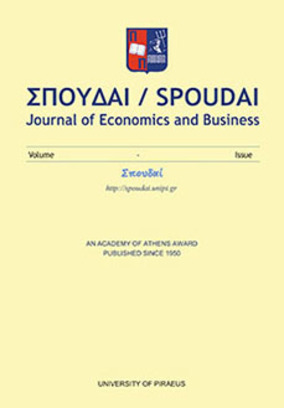Connecting island regions - a qualitative approach to the European experience
Part of : Σπουδαί : journal of economics and business ; Vol.62, No.3-4, 2012, pages 30-53
Issue:
Pages:
30-53
Author:
Abstract:
Island regions are generally dependent on transport services in order to retain cohesion with the mainland and for their socioeconomic development. Europe with its geography presents a number of island areas, with distinct characteristics, and transport needs. This paper focuses on the connectivity issue of these areas and attempts to address a number of questions concerning levels of service. By examining the general characteristics as well as the transport situation of these regions, the main factors affecting service levels are highlighted and possible general as well as specific policy options are considered.
Subject:
Subject (LC):
Keywords:
regional development, cohesion policy, regional transportation, aviation, ferries, island regions
Notes:
Περιέχει εικόνες, πίνακες και βιβλιογραφία
References (1):
- Chlomoudis, C.I., Kostagiolas, P.A., Papadimitriou, S., Tzannatos, E.S., 2011. A European perspectiveon public service obligations for island transport services. Maritime Economics &Logistics, Vol. 13, pp. 342-354.Chlomoudis, C.I., Pallis, P.L., Papadimitriou, S., Tzannatos, E.S., 2007. The liberalisation of ma -ritime transport and the island regions in EU. Evidence from Greece. European Transport,No 37, pp. 1-15.Donzelli, M., 2010. The effect of low-cost air transportation on the local economy: Evidence fromSouthern Italy. Journal of Air Transport Management, Vol. 16, pp. 121-126.European Commission, 2011a. White Paper - Roadmap to a Single European Transport Area – Towardsa competitive and resource efficient transport system, 28.3.2011, COM(2011) 144.European Commission, 2011b. Commission Staff Working Paper, Impact Assessment accompanyingthe White Paper - Roadmap to a Single European Transport Area – Towards a competitiveand resource efficient transport system, 28.3.2011, SEC(2011) 358.European Commission, 2010a. EUROPE 2020 – A strategy for smart, sustainable and inclusivegrowth. 3.3.2010, COM(2010) 2020.European Commission, 2010b. Analyses of the European air transport market - Annual Report2009. Study carried out for the European Commission by Deutsches Zentrum fu..r Luft- undRaumfahrt e.V. www.ec.europa.eu, accessed March 2012.European Commission, 2011a, Roadmap to a Single European Transport Area – Towards a competitiveand resource efficient transport system, 28.3.2011, COM(2011) 144.European Commission, 2002. Fourth report on the implementation of Council Regulation 3577/92applying the principle of freedom to provide services to maritime cabotage (1999-2000).24.4.2002, COM(2002) 203.Hernandez Luis, J.A., 2004. The role of inter-island air transport in the Canary Islands. Journal ofTransport Geography, Vol. 12, pp. 235-244.Jorgensen, F., Pedersen, H., Solvoll, G., 2004. Ramsey Pricing in Practice: The Case of the NorwegianFerries. Transport Policy, Vol. 11, pp. 205-214.Lloyds Register Fairplay, 2008, OPTIMAR – Benchmarking strategic options for European Shippingand for the European maritime transport system in the horizon 2008-2018, Final Report.Study carried out for the European Commission, www.ec.europa.eu, accessed January 2012.Papatheodorou, A., 2008. Civil Aviation Regimes and Leisure Tourism in Europe. Journal of AirTransport Management, Vol. 8, pp. 381-388.Polydoropoulou, A., Litinas, N., 2007. “Demand models for Greek passenger shipping”. Chapter9. Research in Transport Economics. Maritime Transport: The Greek Paradigm. Editor:Thanos Pallis. Publisher: Elsevier Science.Polydoropoulou, A., 2005. Demand analysis in air and sea competitive environment. Aegean University,Chios, (In Greek).Rigas, K., Sambracos, E., Gatzoli, A., 2011. Air and sea transport: Competition strategies undernormal and economic crisis environments. Spoudai Journal of Economics and Business, Vol.16, No 3-4.Rigas, K., 2009. Boat or airplane? Passengers’ perceptions of transport services to islands. The exampleof the Greek domestic leisure market. Journal of Transport Geography, Vol. 17, Issue5, pp. 396-401.Rigas, K., 2007. Research on the competitive and complementary relationship between airline andcoastal shipping services in the Greek region. PhD Thesis, University of Piraeus, (in Greek),available at: http://phdtheses.ekt.gr/eadd/handle/10442/15323, accessed January 2012.Sambracos E., 2001. Air - sea transport: competitiveness or complementarity in the Greek insularmarket. Proceedings “International conference on Air Transport and Airports evolution in the21st Century”, 3-4 December 2001, Technical University of Patras.Spathi, S., 2005. Comparing air and sea passenger movements in domestic lines: econometric estimationof demand. KEPE, Athens, (In Greek).Tsekeris., Th., 2009. Dynamic analysis of air travel demand in competitive island markets. Journalof Air Transport Management, Vol. 15, pp. 267-273.Williams, G., Pagliari, R., 2004. A comparative analysis of the application and use of public ser viceobligations in air transport within the EU. Transport Policy, Vol. 11, pp. 55-66.XRTC, 2007. Competition in the European Ferry Industry – Does Greece Differ from the Rest ofEurope. Piraeus, Greece. www.xrtc.gr, accessed July 2012.




